Climate Change Impacts and Flood Control Measures for Highly Developed Urban Watersheds
Abstract
1. Introduction
2. Materials and Methods
- Alternative proposed in 2004: This alternative consists of a reservoir under Praca da Bandeira (46,000 m³), a reservoir under Praca 14-Bis (36,000 m³), galleries interconnecting them, overland flow catchment, and partial reinforcement of existing galleries under Avenida 9 de Julho. The reservoir under Praca da Bandeira was designed with two wells and an adjacent circular format. According to the project, only those structures will protect the Anhangabau tunnels against events of about five-year recurrence. In the second phase of construction, a reservoir under Praca 14-Bis was proposed, consisting of two adjacent polygonal wells and replacement or repair of existing galleries along Avenida 9 de Julho, ensuring protection against originally planned 25-year return events.
- Alternative proposed in 2006: The main objective for this alternative was to cause as little interference with the transportation system of the region as possible, projected for a 100-year recurrence. The project was proposed based on derivation of the full flow of the catchment area upstream of Praca da Bandeira (estimated at 137.6 m³/s) in a tunnel about 1.6 km long and 6.2 m in diameter, in addition to providing a system of galleries at Avenida 9 de Julho using nondestructive methods. Similarly, considering the position of the bypass tunnel upstream of Praca da Bandeira, it would not be necessary to extend the galleries along Avenida 9 de Julho to the existing galleries in Anhangabau valley.
2.1. Structuring and Implementation of the Model
- Simulated rainfall represents observed rainfall events or defined design storms and future projected storms modified due to climate change.
- Subcatchments contain the information necessary to represent the processes of infiltration, interception, and surface runoff.
- Buildings act as obstructions to overland flow.
- Pathways temporarily store and drain runoff according to surface information.
- Drainage grates and curb inlets make the connection between surface flow and subsurface drainage network, which can also work under pressure.
2.2. Rainfall and Climate Change Scenarios
2.3. Hazard Indices
2.4. Impact on Buildings
3. Results and Discussion
3.1. Surface Water Levels
3.2. Hazard Indices
3.3. Impact on Buildings
4. Conclusions
Author Contributions
Funding
Acknowledgments
Conflicts of Interest
References
- Silva, C.V.F.; Oliveira, C.P.M.; Garcia, J.I.B.; Yazaki, L.F.O.L.; Natale, O.; Brites, A.P.Z. Scenario Evaluation of Alternatives for Flood Control in the Anhangabaú Watershed, Brazil. In Proceedings of the 6th International Conference on Flood Management, São Paulo, Brazil, 16–18 September 2014; ABRH: Nashville, TN, USA, 2014. [Google Scholar]
- Schardong, A.; Srivastav, R.K.; Simonovic, S.P. Update of the intensity-duration-frequency equation for the city of São Paulo under the effect of climate change. RBRH 2014, 19, 176–185. [Google Scholar] [CrossRef]
- Marengo, J.A.; Chou, S.C.; Kay, G.; Alves, L.M.; Pesquero, J.F.; Soares, W.R.; Tavares, P. Development of regional future climate change scenarios in South America using the Eta CPTEC/HadCM3 climate change projections: Climatology and regional analyses for the Amazon, São Francisco and the Paraná River basins. Clim. Dyn. 2011, 38, 1829–1848. [Google Scholar] [CrossRef]
- Semadeni-Davies, A.; Hernebring, C.; Svensson, G.; Gustafsson, L.G. The impacts of climate change and urbanisation on drainage in Helsingborg, Sweden: Combined sewer system. J. Hydrol. 2008, 350, 100–113. [Google Scholar] [CrossRef]
- Hinkel, J.; Lincke, D.; Vafeidis, A.T.; Perrette, M.; Nicholls, R.J.; Tol, R.S.J.; Marzeion, B.; Fettweis, X.; Ionescu, C.; Levermann, A. Coastal flood damage and adaptation costs under 21st century sea-level rise. Proc. Natl. Acad. Sci. USA 2014, 3292–3297. [Google Scholar] [CrossRef] [PubMed]
- Muis, S.; Güneralp, B.; Jongman, B.; Aerts, J.C.J.H.; Ward, P.J. Flood risk and adaptation strategies under climate change and urban expansion: A probabilistic analysis using global data. Sci. Total Environ. 2015, 538, 445–457. [Google Scholar] [CrossRef] [PubMed]
- Muller, M. Adapting to climate change: Water management for urban resilience. Environ. Urban 2007, 19, 99–113. [Google Scholar] [CrossRef]
- Seidou, O.; Ramsay, A.; Nistor, I. Climate change impacts on extreme floods I: Combining imperfect deterministic simulations and non-stationary frequency analysis. Nat. Hazards 2012, 61, 647–659. [Google Scholar] [CrossRef]
- Szewranski, S.; Kazak, J.; Żmuda, R.; Wawer, R. Indicator-based assessment for soil resource management in the Wroclaw larger urban zone of Poland. Pol. J. Environ. Stud. 2017, 26, 2239–2248. [Google Scholar] [CrossRef]
- Zhou, Q.; Mikkelsen, P.S.; Halsnaes, K.; Arnbjerg-Nielsen, K. Framework for economic pluvial flood risk assessment considering climate change effects and adaptation benefits. J. Hydrol. 2012, 414, 539–549. [Google Scholar] [CrossRef]
- Chang, H.K.; Tan, Y.C.; Lai, J.S.; Pan, T.Y.; Liu, T.M.; Tung, C.P. Improvement of a drainage system for flood management with assessment of the potential effects of climate change. Hydrol. Sci. J. 2013, 58, 1581–1597. [Google Scholar] [CrossRef]
- Abdellatif, M.; Atherton, W.; Alkhaddar, R.; Osman, Y. Flood risk assessment for urban water system in a changing climate using artificial neural network. Nat. Hazards 2015, 79, 1059–1077. [Google Scholar] [CrossRef]
- Zhou, Q.; Leng, G.; Huang, M. Impacts of future climate change on urban flood volumes in Hohhot in northern China: Benefits of climate change mitigation and adaptations. Hydrol. Earth Syst. Sci. 2018, 22, 305–316. [Google Scholar] [CrossRef]
- Hammond, M.J.; Chen, A.S.; Djordjević, S.; Butler, D.; Mark, O. Urban flood impact assessment: A state-of-the-art review. Urban Water J. 2015, 12, 14–29. [Google Scholar] [CrossRef]
- U.S. Environmental Protection Agency (US EPA). SWMM 5 Applications Manual; EPA/600/R-09/000; National Risk Management Research Laboratory, Office of Research and Development: Cincinnati, OH, USA, 2009.
- U.S. Environmental Protection Agency (US EPA). Storm Water Management Model Reference Manual Volume III–Water Quality; EPA/600/R-16/093; National Risk Management Research Laboratory, Office of Research and Development: Cincinnati, OH, USA, 2016.
- Jackisch, N.; Markus Weiler, M. The hydrologic outcome of a Low Impact Development (LID) site including superposition with streamflow peaks. Urban Water J. 2017, 14, 143–159. [Google Scholar] [CrossRef]
- Rosa, D.J.; John, C.C.; Michael, E.D. Calibration and Verification of SWMM for Low Impact Development. J. Am. Water Res. Assoc. (JAWRA) 2015, 51, 746–757. [Google Scholar] [CrossRef]
- CHI. PCSWMM. 2018. Available online: https://www.pcswmm.com/ (accessed on 8 June 2018).
- Rossman, L.; Huber, W. Storm Water Management Model Reference Manual Volume I, Hydrology; EPA/600/R-15/162A; US EPA Office of Research and Development: Washington, DC, USA, 2015.
- U.S. Environmental Protection Agency (US EPA). Storm Water Management Model Reference Manual Volume III—Water Quality; EPA/600/R-16/093; National Risk Management Research Laboratory, Office of Research and Development: Cincinnati, OH, USA, 2016.
- Gironas, J.; Roesner, L.; Rossman, L.A.; Davis, J. A new applications manual for the Storm Water Management Model (SWMM). Environ. Model. Softw. 2010, 25, 813–814. [Google Scholar] [CrossRef]
- Song, J.Y.; Chung, E.S. A multi-criteria decision analysis framework for prioritizing sites and types of low impact development practices. Water 2017, 9, 291. [Google Scholar] [CrossRef]
- Ahiablame, L.; Shakya, R. Modeling flood reduction effects of low impact development at a watershed scale. J. Environ. Manag. 2016, 171, 81–91. [Google Scholar] [CrossRef] [PubMed]
- Aryal, S.K.; Ashbolt, S.; McIntosh, B.S.; Petrone, K.P.; Maheepala, S.; Chowdhury, R.K.; Gardener, T.; Gardiner, R. Assessing and mitigating the hydrological impacts of urbanisation in semi-urban catchments using the storm water management model. Water Resour. Manag. 2016, 30, 5437–5454. [Google Scholar] [CrossRef]
- Cipolla, S.S.; Maglionico, M.; Stojkov, I. A long-term hydrological modelling of an extensive green roof by means of SWMM. Ecol. Eng. 2016, 95, 876–887. [Google Scholar] [CrossRef]
- Yang, Y.; Chui, T.F.M. Rapid Assessment of Hydrologic Performance of Low Impact Development Practices under Design Storms. J. Am. Water Resour. Asso. 2018, 54, 613–630. [Google Scholar] [CrossRef]
- Liu, Y.; Bralts, V.F.; Engel, B.A. Evaluating the effectiveness of management practices on hydrology and water quality at watershed scale with a rainfall-runoff model. Sci. Total Environ. 2015, 511, 298–308. [Google Scholar] [CrossRef] [PubMed]
- Tomaz, P. Hydrological and Hydraulic Calculations for Municipal Works. Navegar 2012. (In Portuguese) [Google Scholar]
- Millington, N.; Samiran, D.; Simonovic, S.P. The Comparison of GEV, Log-Pearson Type 3 and Gumbel Distributions in the upper Thames River Watershed under Global Climate Models; Water Resources Research Report No. 077; Facility for Intelligent Decision Support, Department of Civil and Environmental Engineering: London, UK; Ontario, ON, Canada, 2011; p. 53. ISBN 978-0-7714-2898-2.
- Hosking, J.R.M.; Wallis, J.R. Regional Frequency Analysis; Cambridge University Press: Cambridge, UK, 1997. [Google Scholar]
- Schardong, A.; Simonovic, S.P.; Sandink, D. Computerized Tool for the Development of Intensity-Duration-Frequency Curves under a Changing Climate: Technical Manual v.3; Water Resources Research Report No. 103; Facility for Intelligent Decision Support, Department of Civil and Environmental Engineering: London, UK; Ontario, ON, Canada, 2018; p. 67. ISBN 978-0-7714-3107-4.
- Martinez Junior, F.; Magni, N.L.G. Equations of intense rainfall in the State of Sao Paulo; Department of Water and Electric Power, Polytechnic School of the University of Sao Paulo: Sao Paulo, Brazil, 1999; p. 125. (In Portuguese) [Google Scholar]
- Simonovic, S.P.; Schardong, A.; Sandink, D.; Srivastav, R. A Web-based Tool for the Development of Intensity Duration Frequency Curves under Changing Climate. Environ. Model. Softw. J. 2016, 81, 136–153. [Google Scholar] [CrossRef]
- Sandink, D.; Simonovic, S.P.; Schardong, A.; Srivastav, R. A Decision Support System for Updating and Incorporating Climate Change Impacts into Rainfall Intensity-DurationFrequency Curves: Review of the Stakeholder Involvement Process. Environ. Model. Softw. J. 2016, 84, 193–209. [Google Scholar] [CrossRef]
- Schardong, A.; Simonovic, S.P.; Sandink, D. Computerized Tool for the Development of Intensity-Duration-Frequency Curves under a Changing Climate: User’s Manual v.3; Water Resources Research Report No. 104; Facility for Intelligent Decision Support, Department of Civil and Environmental Engineering: London, UK; Ontario, ON, Canada, 2018; p. 80. ISBN 978-0-7714-3108-1.
- Abt, S.R.; Wittler, R.J.; Taylor, A.; Love, D.J. Human stability in a high flood hazard zone. Water Res. Bull. 1989, 25, 881–890. [Google Scholar] [CrossRef]
- Jonkman, S.N.; Vrijling, J.K.; Vrouwenvelder, A.C.W.M. Methods for the estimation of loss of life due to floods: A literature review and a proposal for a new method. Nat. Hazards 2008, 46, 353–389. [Google Scholar] [CrossRef]
- Shand, T.D.; Smith, G.P.; Cox, R.J.; Blacka, M. Development of Appropriate Criteria for the Safety and Stability of Persons and Vehicles in Floods. In Proceedings of the 34th IAHR Conference, Brisbane, Australia, 26 June–1 July 2011. [Google Scholar]
- Russo, B.; Gómez, M.; Macchione, F. Pedestrian hazard criteria for flooded urban areas. Nat. Hazards 2013, 69, 251–265. [Google Scholar] [CrossRef]
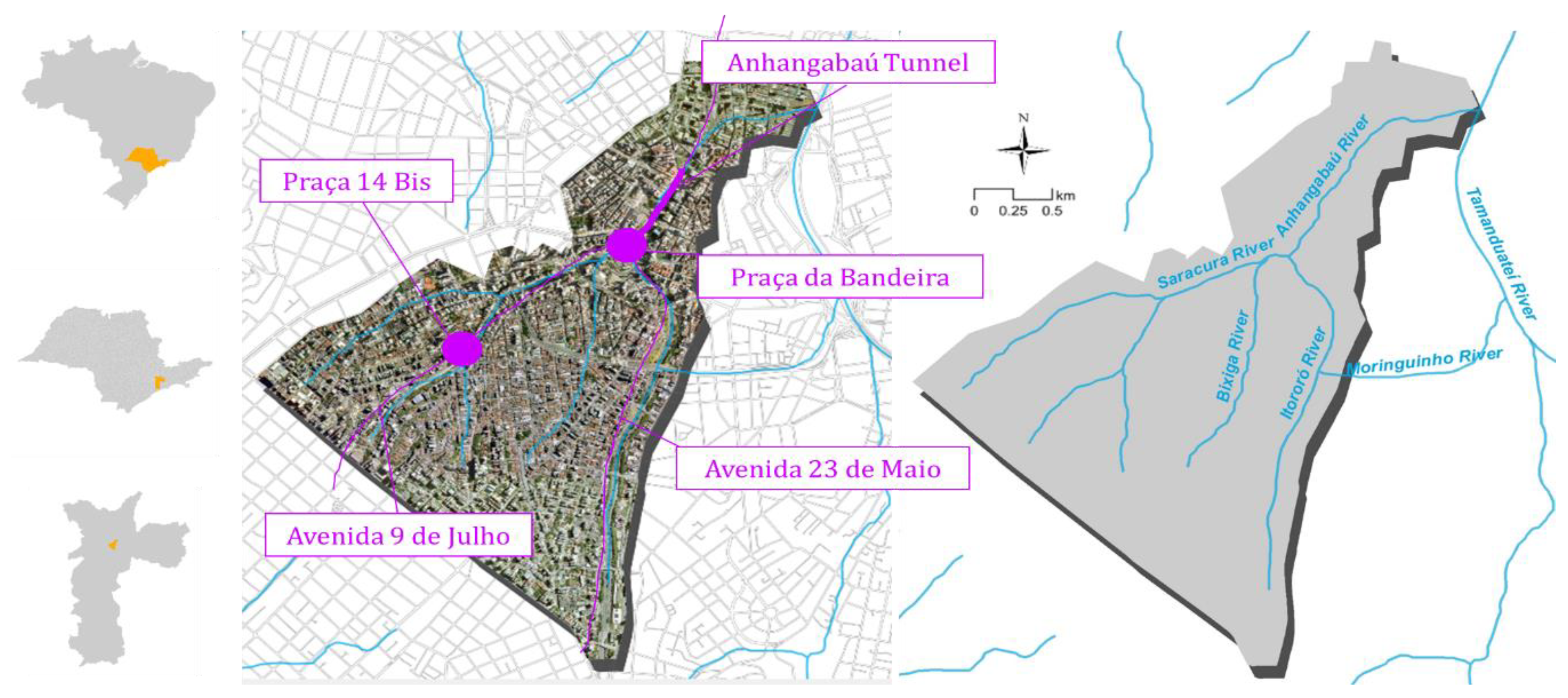
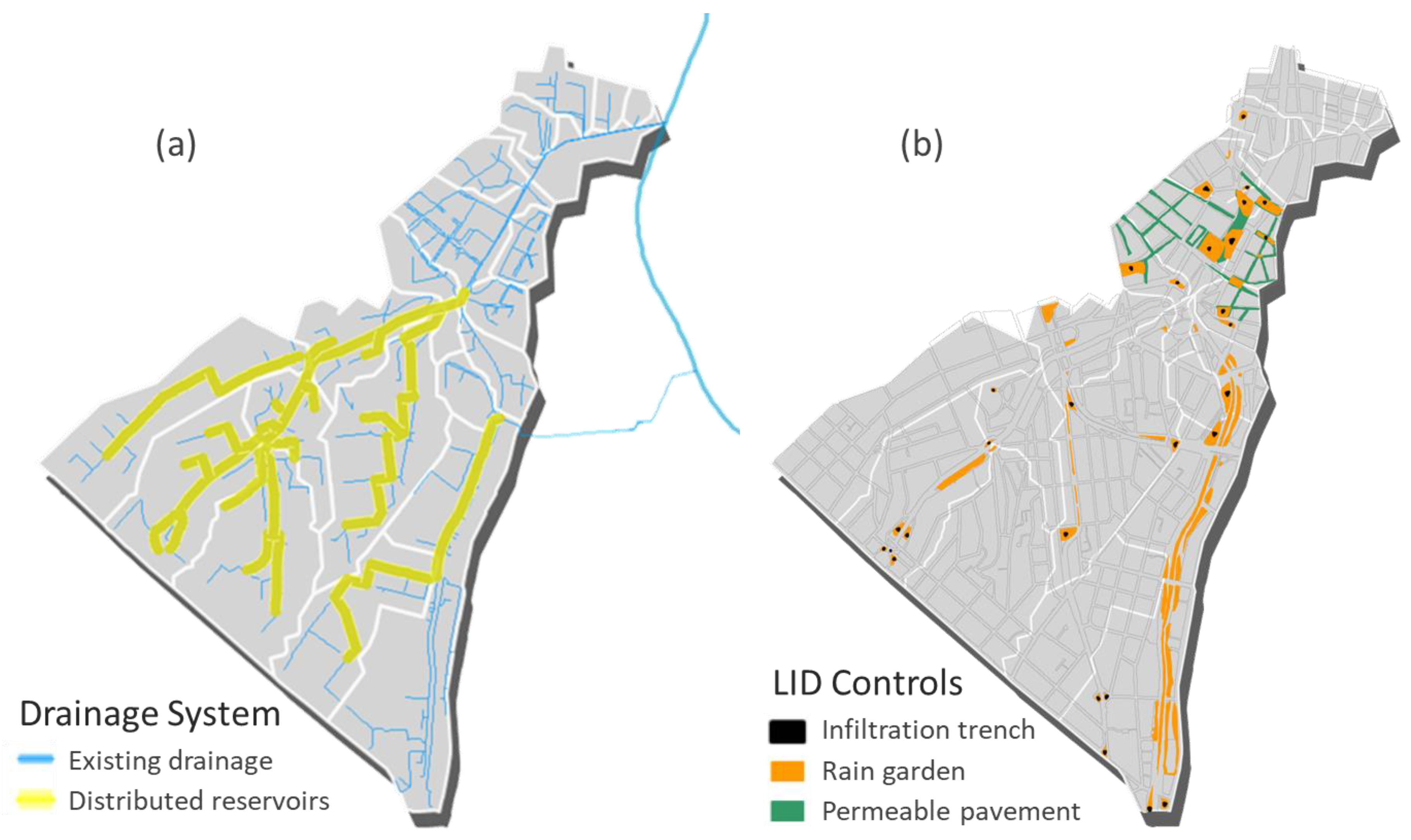
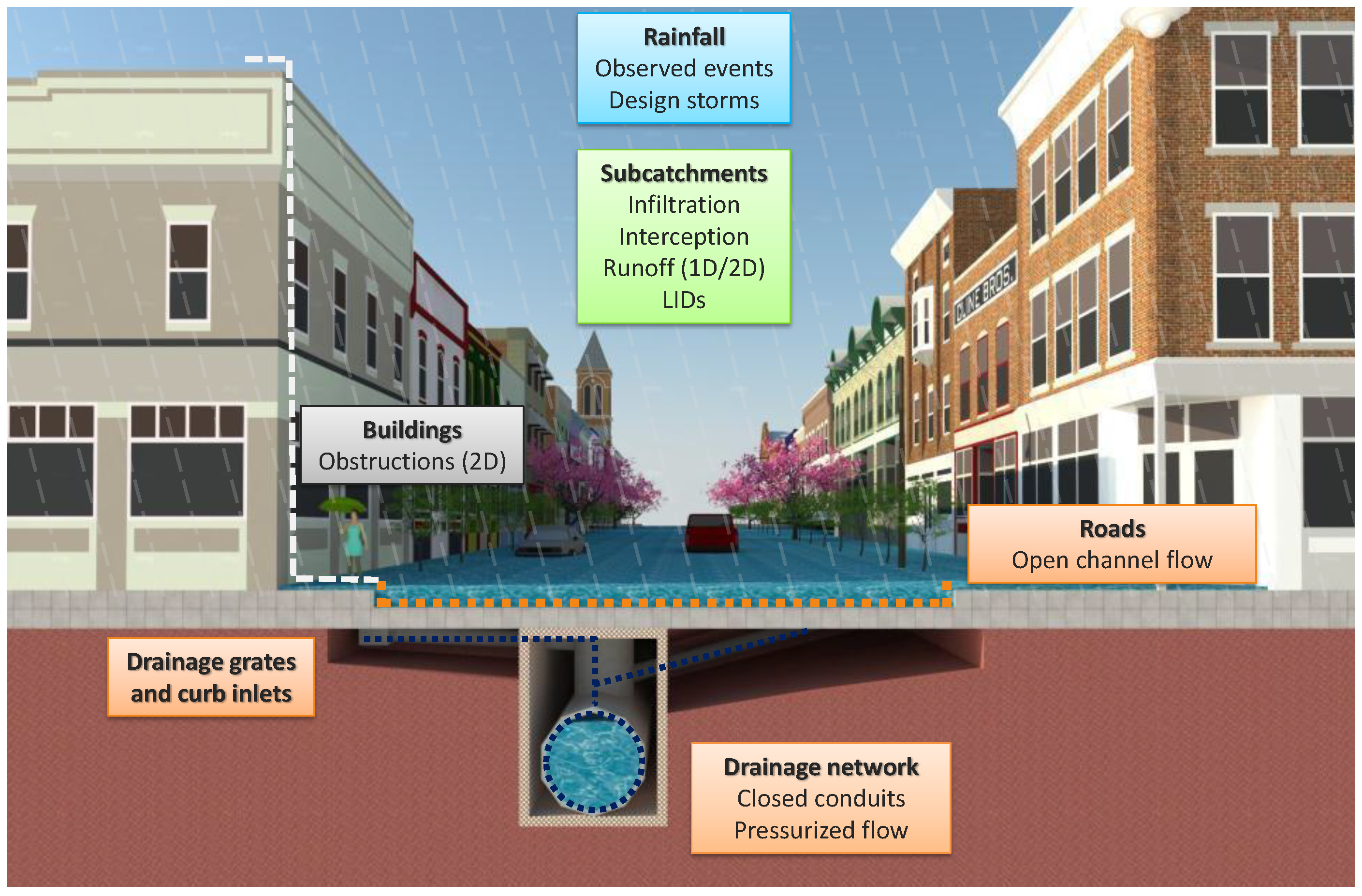


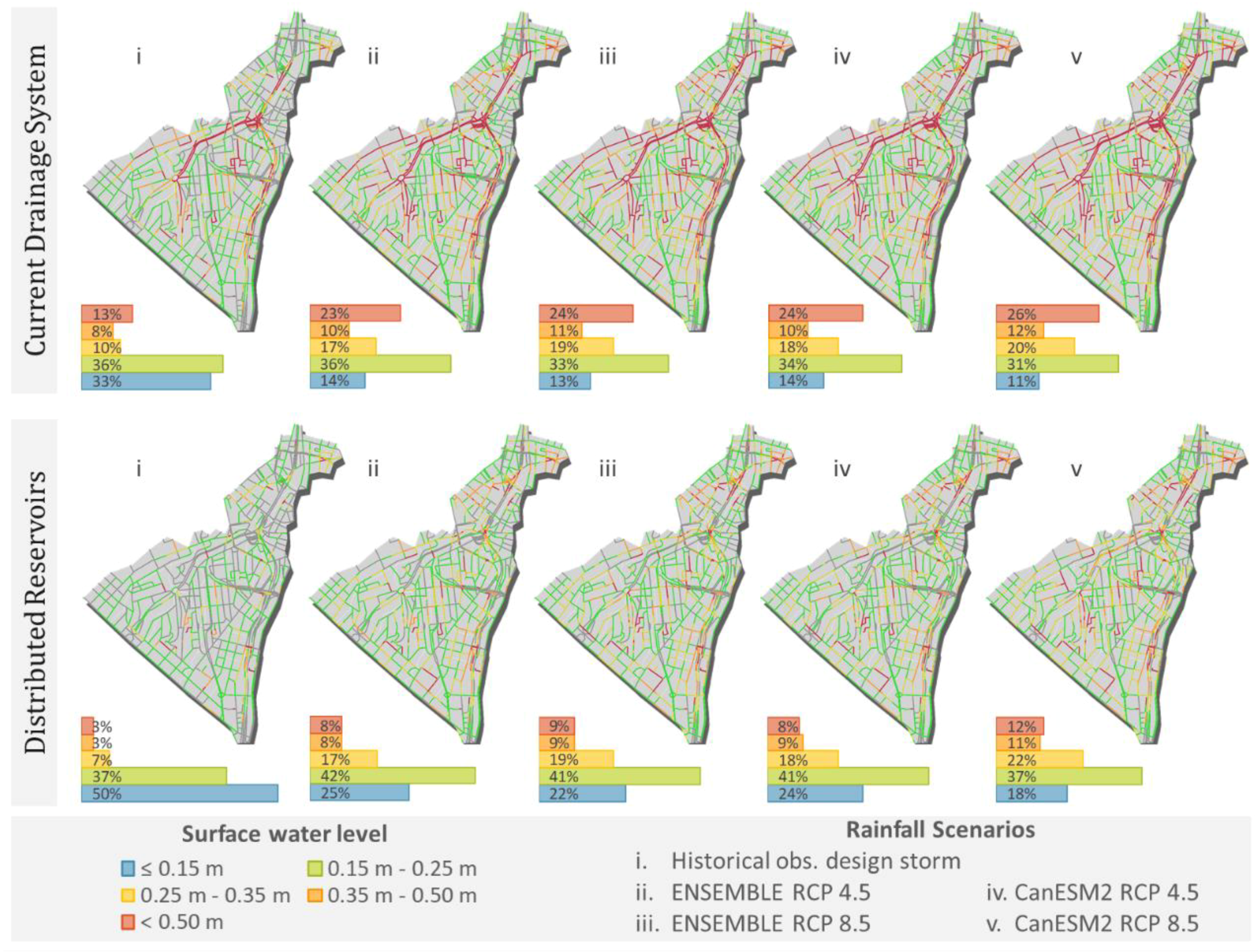

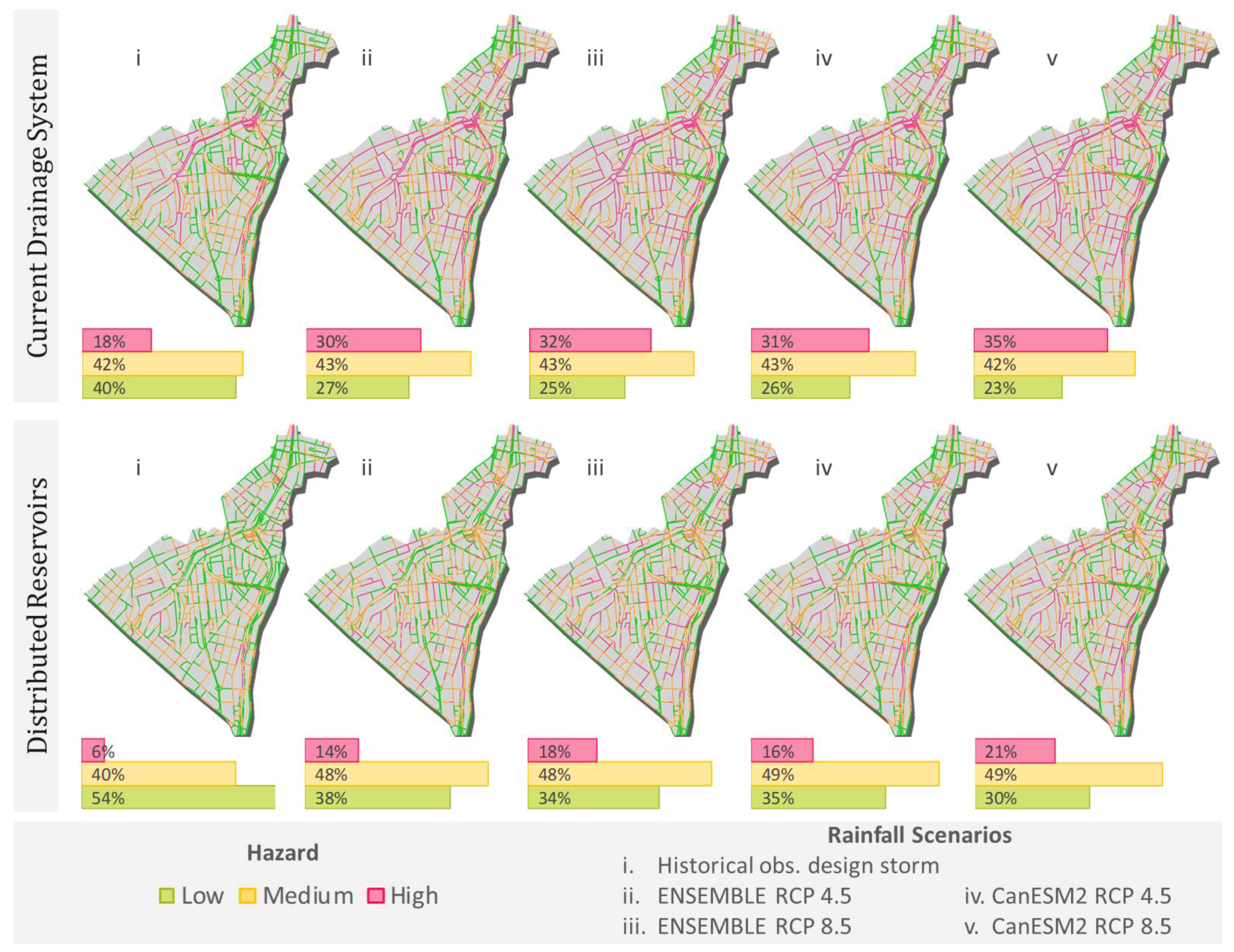
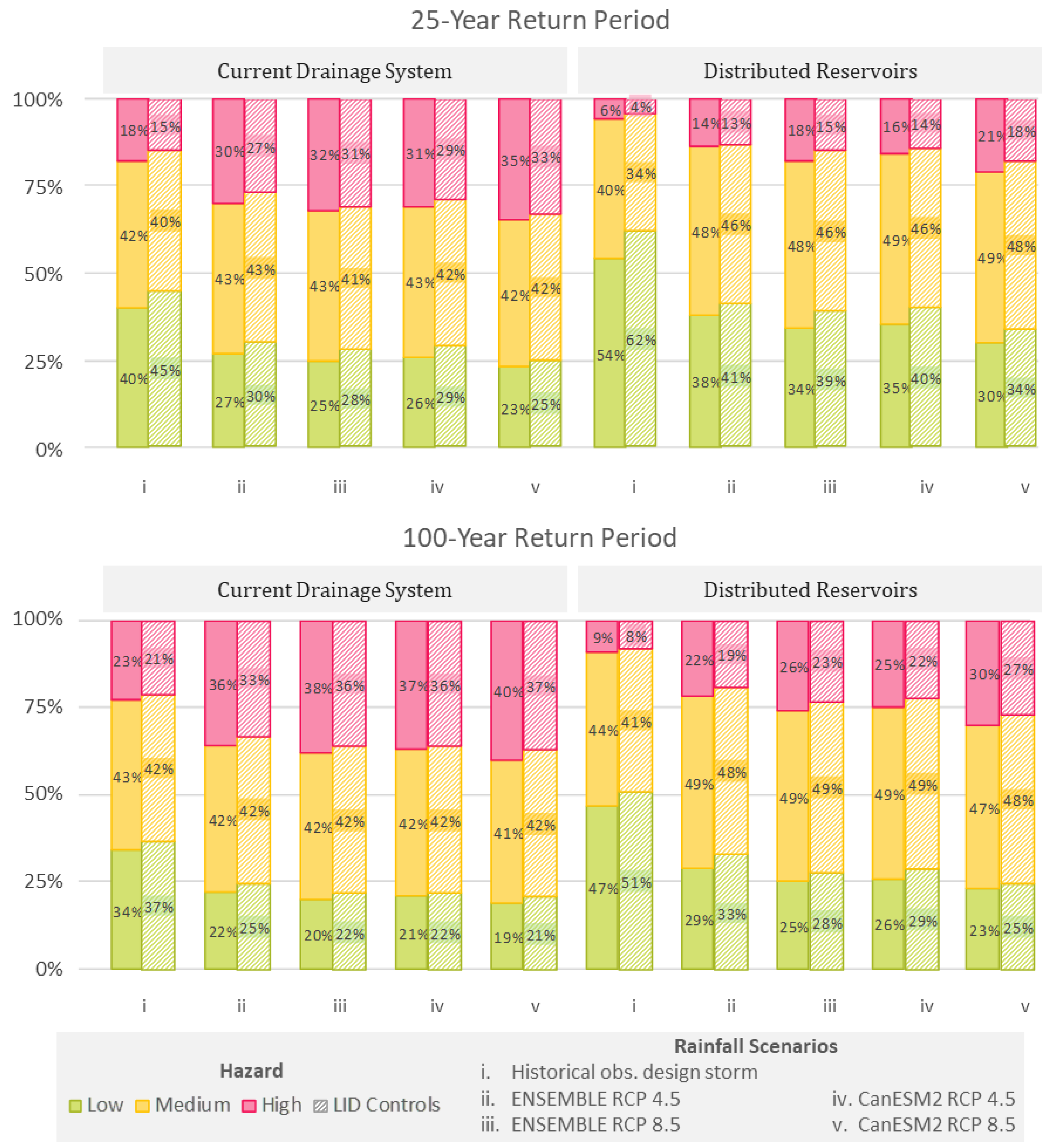
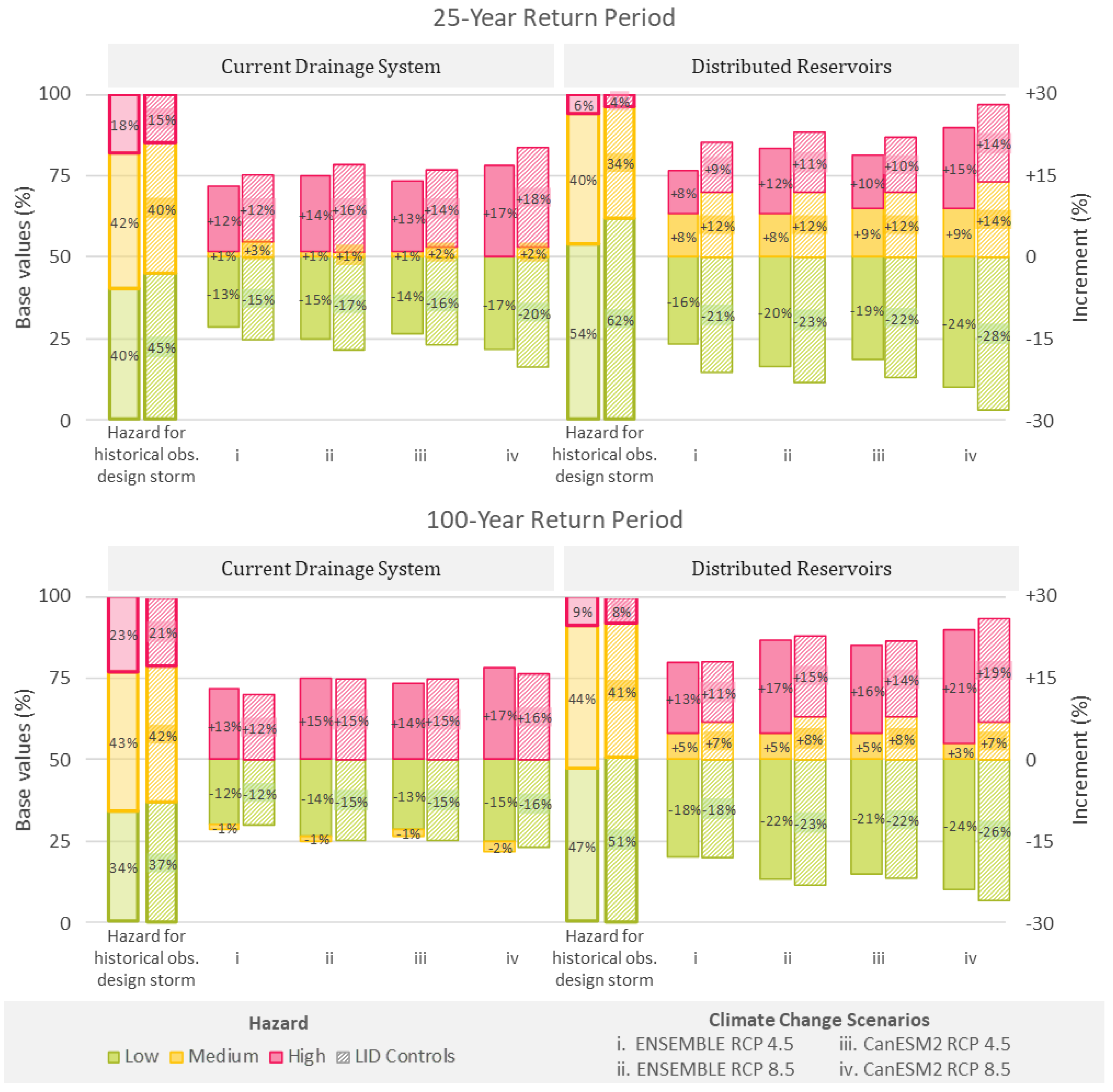
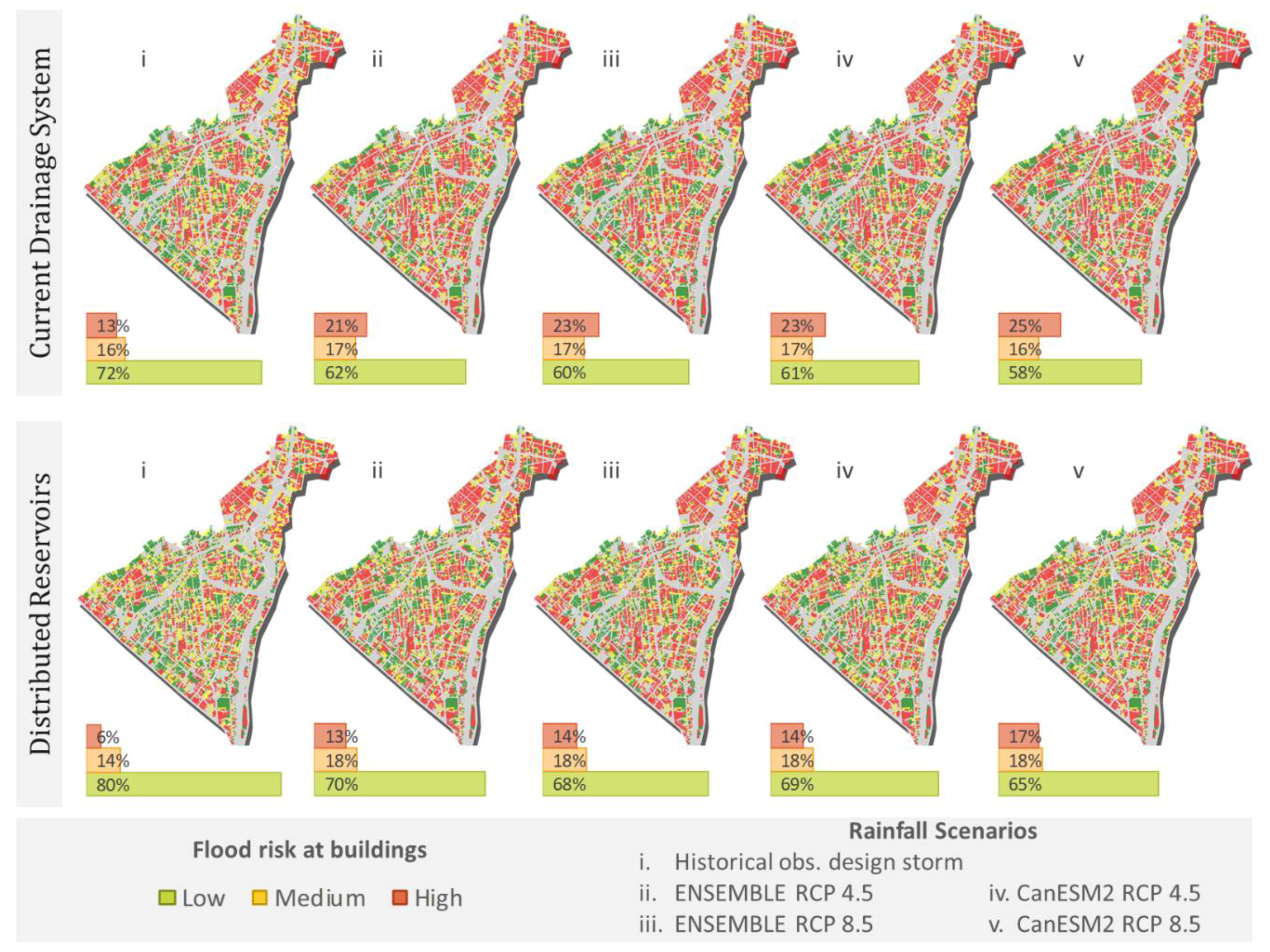
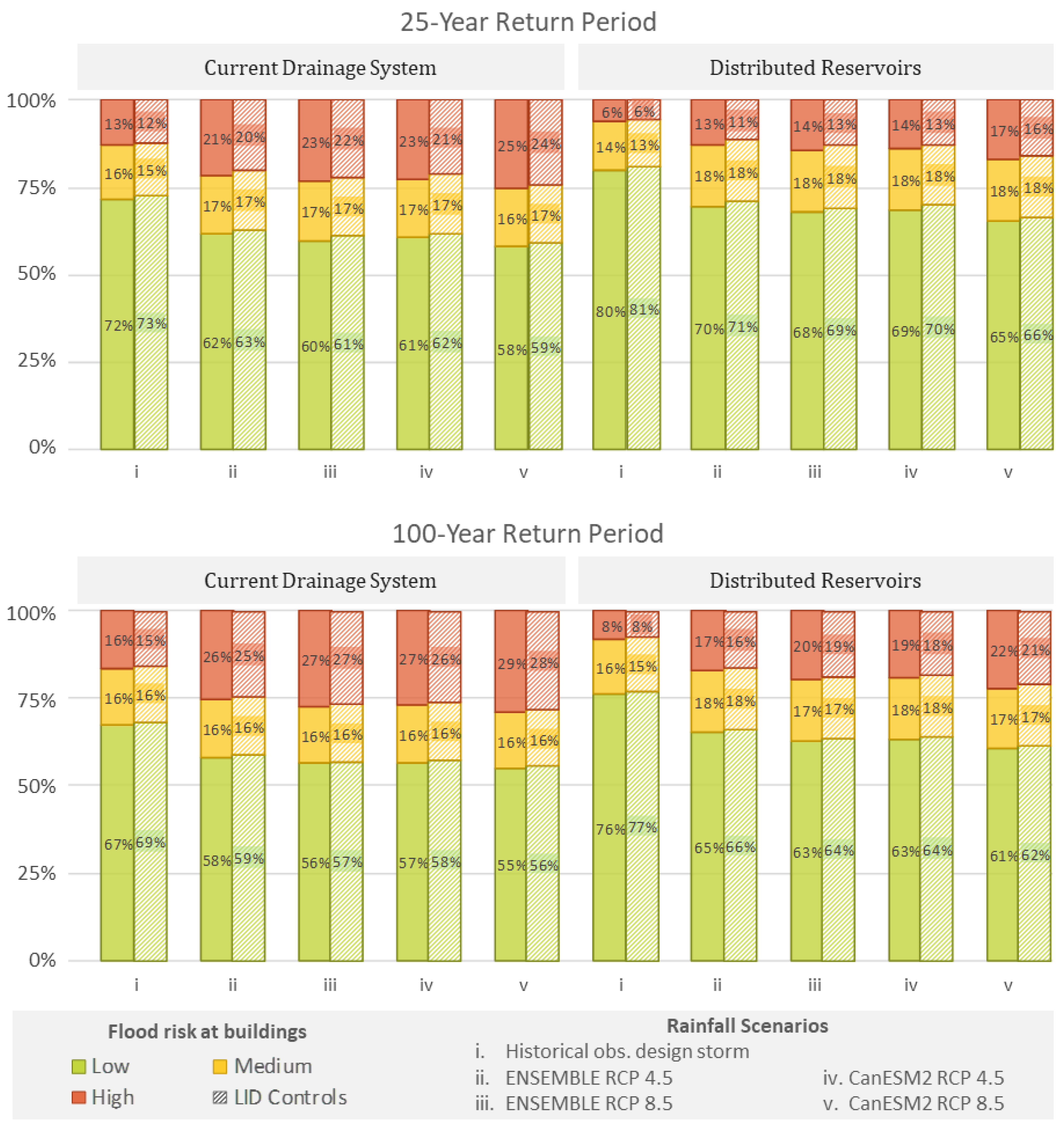
| RP (Years) | Historical | ENS RCP 4.5 | ENS RCP 8.5 | CanESM2 RCP 4.5 | CanESM2 RCP 8.5 | ||||
|---|---|---|---|---|---|---|---|---|---|
| Total (mm) | Total (mm) | Change (%) | Total (mm) | Change (%) | Total (mm) | Change (%) | Total (mm) | Change (%) | |
| 2 | 46.8 | 60.8 | 29.9 | 55.5 | 18.6 | 63.5 | 35.6 | 71.9 | 53.6 |
| 5 | 62.1 | 81.4 | 31.0 | 77.9 | 25.4 | 84.3 | 35.7 | 95.4 | 53.6 |
| 10 | 72.3 | 94.7 | 31.0 | 93.8 | 29.8 | 98.0 | 35.6 | 111.0 | 53.6 |
| 25 | 85.1 | 109.4 | 28.7 | 113.0 | 32.8 | 115.5 | 35.7 | 130.5 | 53.5 |
| 50 | 94.6 | 120.4 | 27.3 | 126.9 | 34.2 | 128.4 | 35.7 | 144.3 | 52.6 |
| 100 | 104.0 | 131.2 | 26.2 | 140.4 | 35.0 | 141.1 | 35.6 | 151.8 | 45.9 |
© 2018 by the authors. Licensee MDPI, Basel, Switzerland. This article is an open access article distributed under the terms and conditions of the Creative Commons Attribution (CC BY) license (http://creativecommons.org/licenses/by/4.0/).
Share and Cite
Da Silva, C.V.F.; Schardong, A.; Garcia, J.I.B.; Oliveira, C.D.P.M. Climate Change Impacts and Flood Control Measures for Highly Developed Urban Watersheds. Water 2018, 10, 829. https://doi.org/10.3390/w10070829
Da Silva CVF, Schardong A, Garcia JIB, Oliveira CDPM. Climate Change Impacts and Flood Control Measures for Highly Developed Urban Watersheds. Water. 2018; 10(7):829. https://doi.org/10.3390/w10070829
Chicago/Turabian StyleDa Silva, Carla Voltarelli Franco, Andre Schardong, Joaquin Ignacio Bonnecarrère Garcia, and Cristiano De Pádua Milagres Oliveira. 2018. "Climate Change Impacts and Flood Control Measures for Highly Developed Urban Watersheds" Water 10, no. 7: 829. https://doi.org/10.3390/w10070829
APA StyleDa Silva, C. V. F., Schardong, A., Garcia, J. I. B., & Oliveira, C. D. P. M. (2018). Climate Change Impacts and Flood Control Measures for Highly Developed Urban Watersheds. Water, 10(7), 829. https://doi.org/10.3390/w10070829




